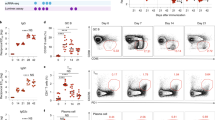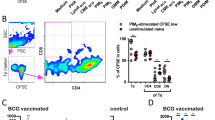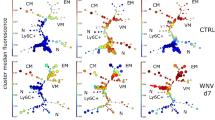Abstract
CD8+ T cells are essential for long-term, vaccine-induced resistance against intracellular pathogens. Here we show that natural antibodies, acting in concert with complement, are endogenous adjuvants for the generation of protective CD8+ T cells after vaccination against visceral leishmaniasis. IL-4 was crucial for the priming of vaccine-specific CD8+ T cells, and we defined the primary source of IL-4 as a CD11b+CD11clo phagocyte. IL-4 secretion was not observed in antibody-deficient mice and could be reconstituted with serum from normal, but not Btk immune-deficient, mice. Similarly, no IL-4 response or CD8+ T-cell priming was seen in C1qa−/− mice. These results identify a new pathway by which immune complex–mediated complement activation can regulate T-cell-mediated immunity. We propose that this function of natural antibodies could be exploited when developing new vaccines for infectious diseases.
This is a preview of subscription content, access via your institution
Access options
Subscribe to this journal
Receive 12 print issues and online access
$209.00 per year
only $17.42 per issue
Buy this article
- Purchase on Springer Link
- Instant access to full article PDF
Prices may be subject to local taxes which are calculated during checkout






Similar content being viewed by others
References
Yoshida, A., Nagata, T., Uchijima, M. & Koide, Y. Protective CTL response is induced in the absence of CD4+ T cells and IFN-gamma by gene gun DNA vaccination with a minigene encoding a CTL epitope of Listeria monocytogenes. Vaccine 19, 4297–4306 (2001).
Stager, S., Smith, D.F. & Kaye, P.M. Immunization with a recombinant stage-regulated surface protein from Leishmania donovani induces protection against visceral leishmaniasis. J. Immunol. 165, 7064–7071 (2000).
Carvalho, L.H. et al. IL-4-secreting CD4+ T cells are crucial to the development of CD8+ T-cell responses against malaria liver stages. Nat. Med. 8, 166–170 (2002).
Gurunathan, S., Wu, C.Y., Freidag, B.L. & Seder, R.A. DNA vaccines: a key for inducing long-term cellular immunity. Curr. Opin. Immunol. 12, 442–447 (2000).
Gardner, M.J. et al. Genome sequence of the human malaria parasite Plasmodium falciparum. Nature 419, 498–511 (2002).
Kalergis, A.M. & Ravetch, J.V. Inducing tumor immunity through the selective engagement of activating Fcgamma receptors on dendritic cells. J. Exp. Med. 195, 1653–1659 (2002).
Regnault, A. et al. Fcgamma receptor-mediated induction of dendritic cell maturation and major histocompatibility complex class I-restricted antigen presentation after immune complex internalization. J. Exp. Med. 189, 371–380 (1999).
Tobery, T.W. & Siliciano, R.F. Targeting of HIV-1 antigens for rapid intracellular degradation enhances cytotoxic T lymphocyte (CTL) recognition and the induction of de novo CTL responses in vivo after immunization. J. Exp. Med. 185, 909–920 (1997).
Dranoff, G. et al. Vaccination with irradiated tumor cells engineered to secrete murine granulocyte-macrophage colony-stimulating factor stimulates potent, specific, and long-lasting anti-tumor immunity. Proc. Natl. Acad. Sci. USA 90, 3539–3543 (1993).
Kopf, M., Abel, B., Gallimore, A., Carroll, M. & Bachmann, M.F. Complement component C3 promotes T-cell priming and lung migration to control acute influenza virus infection. Nat. Med. 8, 373–378 (2002).
Suresh, M. et al. Complement component 3 is required for optimal expansion of CD8 T cells during a systemic viral infection. J. Immunol. 170, 788–794 (2003).
Haas, K.M. et al. Complement receptors CD21/35 link innate and protective immunity during Streptococcus pneumoniae infection by regulating IgG3 antibody responses. Immunity 17, 713–723 (2002).
Hayakawa, K., Hardy, R.R. & Herzenberg, L.A. Peritoneal Ly-1 B cells: genetic control, autoantibody production, increased lambda light chain expression. Eur. J. Immunol. 16, 450–456 (1986).
Hardy, R.R., Carmack, C.E., Li, Y.S. & Hayakawa, K. Distinctive developmental origins and specificities of murine CD5+ B cells. Immunol. Rev. 137, 91–118 (1994).
Martin, F., Oliver, A.M. & Kearney, J.F. Marginal zone and B1 B cells unite in the early response against T-independent blood-borne particulate antigens. Immunity 14, 617–629 (2001).
Reid, R.R. et al. Endotoxin shock in antibody-deficient mice: unraveling the role of natural antibody and complement in the clearance of lipopolysaccharide. J. Immunol. 159, 970–975 (1997).
Alce, T.M., Gokool, S., McGhie, D., Stager, S. & Smith, D.F. Expression of hydrophilic surface proteins in infective stages of Leishmania donovani. Mol. Biochem. Parasitol. 102, 191–196 (1999).
Biedermann, T. et al. IL-4 instructs TH1 responses and resistance to Leishmania major in susceptible BALB/c mice. Nat. Immunol. 2, 1054–1060 (2001).
Mohrs, M., Shinkai, K., Mohrs, K. & Locksley, R.M. Analysis of type 2 immunity in vivo with a bicistronic IL-4 reporter. Immunity 15, 303–311 (2001).
Naito, M. et al. Development, differentiation, and phenotypic heterogeneity of murine tissue macrophages. J. Leukoc. Biol. 59, 133–138 (1996).
Seder, R.A. et al. Mouse splenic and bone marrow cell populations that express high-affinity Fc epsilon receptors and produce interleukin 4 are highly enriched in basophils. Proc. Natl. Acad. Sci. USA 88, 2835–2839 (1991).
Coffman, R.L. & von der Weid, T. Multiple pathways for the initiation of T helper 2 (Th2) responses. J. Exp. Med. 185, 373–375 (1997).
Wardemann, H., Boehm, T., Dear, N. & Carsetti, R. B-1a B cells that link the innate and adaptive immune responses are lacking in the absence of the spleen. J. Exp. Med. 195, 771–780 (2002).
Boes, M. et al. Enhanced B-1 cell development, but impaired IgG antibody responses in mice deficient in secreted IgM. J. Immunol. 160, 4776–4787 (1998).
Bona, C., Mond, J.J. & Paul, W.E. Synergistic genetic defect in B-lymphocyte function. I. Defective responses to B-cell stimulants and their genetic basis. J. Exp. Med. 151, 224–234 (1980).
Khan, W.N. et al. Defective B cell development and function in Btk-deficient mice. Immunity 3, 283–299 (1995).
Lutz, C. et al. IgD can largely substitute for loss of IgM function in B cells. Nature 393, 797–801 (1998).
Botto, M. et al. Homozygous C1q deficiency causes glomerulonephritis associated with multiple apoptotic bodies. Nat. Genet. 19, 56–59 (1998).
Schuler, T. et al. Generation of tumor-associated cytotoxic T lymphocytes requires interleukin 4 from CD8(+) T cells. J. Exp Med. 194, 1767–1775 (2001).
King, C. et al. Interleukin-4 acts at the locus of the antigen-presenting dendritic cell to counter-regulate cytotoxic CD8+ T-cell responses. Nat. Med. 7, 206–214 (2001).
Gicheru, M.M. et al. Vervet monkeys vaccinated with killed Leishmania major parasites and interleukin-12 develop a type 1 immune response but are not protected against challenge infection. Infect. Immun. 69, 245–251 (2001).
Kenney, R.T. et al. Protective immunity using recombinant human IL-12 and alum as adjuvants in a primate model of cutaneous leishmaniasis. J. Immunol. 163, 4481–4488 (1999).
O'Garra, A. Cytokines induce the development of functionally heterogeneous T helper cell subsets. Immunity 8, 275–283 (1998).
Hochrein, H. et al. Interleukin (IL)-4 is a major regulatory cytokine governing bioactive IL-12 production by mouse and human dendritic cells. J. Exp. Med. 192, 823–833 (2000).
Brown, M.A. et al. B cell stimulatory factor-1/interleukin-4 mRNA is expressed by normal and transformed mast cells. Cell 50, 809–818 (1987).
O'Keeffe, M. et al. Dendritic cell precursor populations of mouse blood: identification of the murine homologues of human blood plasmacytoid pre-DC2 and CD11c+ DC1 precursors. Blood 101, 1453–1459 (2003).
Hayashi, N. et al. Kupffer cells from Schistosoma mansoni-infected mice participate in the prompt type 2 differentiation of hepatic T cells in response to worm antigens. J. Immunol. 163, 6702–6711 (1999).
Qi, H., Popov, V. & Soong, L. Leishmania amazonensis-dendritic cell interactions in vitro and the priming of parasite-specific CD4(+) T cells in vivo. J. Immunol. 167, 4534–4542 (2001).
Swain, S.L., McKenzie, D.T., Dutton, R.W., Tonkonogy, S.L. & English, M. The role of IL4 and IL5: characterization of a distinct helper T cell subset that makes IL4 and IL5 (Th2) and requires priming before induction of lymphokine secretion. Immunol. Rev. 102, 77–105 (1988).
Gordon, S. Alternative activation of macrophages. Nat. Rev. Immunol. 3, 23–35 (2003).
Ross, T.M., Xu, Y., Bright, R.A. & Robinson, H.L. C3d enhancement of antibodies to hemagglutinin accelerates protection against influenza virus challenge. Nat. Immunol. 1, 127–131 (2000).
Dempsey, P.W., Allison, M.E., Akkaraju, S., Goodnow, C.C. & Fearon, D.T. C3d of complement as a molecular adjuvant: bridging innate and acquired immunity. Science 271, 348–350 (1996).
Ochsenbein, A.F. & Zinkernagel, R.M. Natural antibodies and complement link innate and acquired immunity. Immunol. Today 21, 624–630 (2000).
Mohrs, M. et al. Differences between IL-4- and IL-4 receptor alpha-deficient mice in chronic leishmaniasis reveal a protective role for IL-13 receptor signaling. J. Immunol. 162, 7302–7308 (1999).
Yamaguchi, M. et al. Regulation of mouse mast cell surface Fc epsilon RI expression by dexamethasone. Int. Immunol. 13, 843–851 (2001).
Murphy, M.L., Cotterell, S.E., Gorak, P.M., Engwerda, C.R. & Kaye, P.M. Blockade of CTLA-4 enhances host resistance to the intracellular pathogen, Leishmania donovani. J. Immunol. 161, 4153–4160 (1998).
Fleming, T.J., Fleming, M.L. & Malek, T.R. Selective expression of Ly-6G on myeloid lineage cells in mouse bone marrow. RB6-8C5 mAb to granulocyte-differentiation antigen (Gr-1) detects members of the Ly-6 family. J. Immunol. 151, 2399–2408 (1993).
Van Rooijen, N. & Sanders, A. Liposome mediated depletion of macrophages: mechanism of action, preparation of liposomes and applications. J. Immunol. Methods 174, 83–93 (1994).
Ogawa, M. et al. Expression and function of c-kit in hemopoietic progenitor cells. J. Exp. Med. 174, 63–71 (1991).
Ato, M., Stager, S., Engwerda, C.R. & Kaye, P.M. Defective CCR7 expression on dendritic cells contributes to the development of visceral leishmaniasis. Nat. Immunol. 3, 1185–1191 (2002).
Acknowledgements
This work was supported by the British Medical Research Council and The Wellcome Trust. Clodronate and control liposomes were a gift of Roche Diagnostics. The authors thank J. Langhorne (National Institute for Medical Research) for CBA/N serum, H. Helmby (London School of Hygiene and Tropical Medicine) for ACK2 monoclonal antibody, M. Ato for critical comments on the manuscript, the staff of the Biological Services Facility for animal husbandry and Joanne Warren for technical assistance. F.B. holds a Wellcome Trust Research Senior Fellowship for Medical Science in South Africa (grant no. 056708/Z/99).
Author information
Authors and Affiliations
Corresponding author
Ethics declarations
Competing interests
S.S., D.F.S. and P.M.K. are named inventors on a patent application covering the use of natural antibodies to screen pathogen proteomes for new vaccine candidates (UK Patent Application 03006616.4).
Rights and permissions
About this article
Cite this article
Stäger, S., Alexander, J., Kirby, A. et al. Natural antibodies and complement are endogenous adjuvants for vaccine-induced CD8+ T-cell responses. Nat Med 9, 1287–1292 (2003). https://doi.org/10.1038/nm933
Received:
Accepted:
Published:
Issue Date:
DOI: https://doi.org/10.1038/nm933
This article is cited by
-
A naturally hypersensitive porcine model may help understand the mechanism of COVID-19 mRNA vaccine-induced rare (pseudo) allergic reactions: complement activation as a possible contributing factor
GeroScience (2022)
-
Leishmaniasis immunopathology—impact on design and use of vaccines, diagnostics and drugs
Seminars in Immunopathology (2020)
-
A lentiviral vaccine expressing KMP11-HASPB fusion protein increases immune response to Leishmania major in BALB/C
Parasitology Research (2018)
-
Hydrophilic Acylated Surface Protein A (HASPA) of Leishmania donovani: Expression, Purification and Biophysico-Chemical Characterization
The Protein Journal (2017)
-
Immunopathological characterization of human cutaneous leishmaniasis lesions caused by Leishmania (Viannia) spp. in Amazonian Brazil
Parasitology Research (2017)



